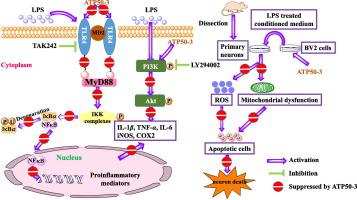International Journal of Biological Macromolecules ( IF 8.2 ) Pub Date : 2020-07-01 , DOI: 10.1016/j.ijbiomac.2020.06.266 Jing Zhong 1 , Xian Qiu 2 , Qian Yu 3 , Haiyun Chen 3 , Chunyan Yan 1

|
Our previous study has indicated that a crude polysaccharide derived from Acorus tatarinowii, AT50, remarkably improves learning and memory in scopolamine-induced amnesic mice and prevents the release of inflammatory mediators. To further explore the bioactive constituents of AT50, a novel polysaccharide (ATP50-3) was purified, and its anti-neuroinflammatory effects and underlying mechanisms were investigated. ATP50-3 significantly reduced abnormal elevation of inflammatory mediators in lipopolysaccharide (LPS)-induced proinflammatory BV2 cells in vitro and inhibited the activation of nuclear factor kappa B (NF-κB). Moreover, ATP50-3 down-regulated LPS-induced protein levels of Toll-like receptor 4 (TLR4), myeloid differentiation primary response protein (MyD88), p-PI3K (phosphoinositide 3-kinase), and p-Akt (protein kinase B). Further experiments demonstrated that TAK242 (a TLR4 inhibitor) and LY294002 (a PI3K inhibitor) remarkably augmented ATP50-3's down-regulation on LPS-induced proinflammatory mediators. Importantly, ATP50-3 provided neuroprotection against neuroinflammation-induced neurotoxicity in primary cortical and hippocampal neurons by mitigating overproduction of reactive oxygen species and damage to the mitochondrial membrane potential (MMP). Taken together, our findings suggest that ATP50-3 exerts anti-neuroinflammatory and neuroprotective effects through modulation of TLR4-mediated MyD88/NF-κB and PI3K/Akt signaling pathways.
中文翻译:

一种来自塔哥A(Acorus tatarinowii)的新型多糖通过抑制TLR4介导的MyD88 /NF-κB和PI3K / Akt信号通路来保护LPS诱导的神经炎症和神经毒性。
我们以前的研究表明,粗叶多糖来源于塔哥(Acorus tatarinowii),AT50,显着改善东pol碱诱导的记忆删除小鼠的学习和记忆,并防止炎症介质的释放。为了进一步探索AT50的生物活性成分,纯化了一种新型多糖(ATP50-3),并研究了其抗神经炎症作用及其潜在机制。ATP50-3显着降低了脂多糖(LPS)诱导的促炎性BV2细胞中炎症介质异常升高,并抑制了核因子kappa B(NF-κB)的激活。此外,ATP50-3下调了Toll样受体4(TLR4),髓样分化初级反应蛋白(MyD88),p-PI3K(磷酸肌醇3激酶)和p-Akt(蛋白激酶B)诱导的LPS诱导的蛋白水平。 )。进一步的实验表明TAK242(一种TLR4抑制剂)和LY294002(一种PI3K抑制剂)显着增强了LPS诱导的促炎介质对ATP50-3的下调。重要的是,ATP50-3通过减轻活性氧的过量产生和线粒体膜电位(MMP)的损伤,为原发性皮层和海马神经元的神经炎症诱导的神经毒性提供了神经保护作用。两者合计,我们的发现表明,ATP50-3通过调节TLR4介导的MyD88 /NF-κB和PI3K / Akt信号通路发挥抗神经炎和神经保护作用。ATP50-3通过减轻活性氧的过量产生和线粒体膜电位(MMP)的损伤,为原发皮层和海马神经元的神经炎症诱导的神经毒性提供了神经保护作用。两者合计,我们的发现表明,ATP50-3通过调节TLR4介导的MyD88 /NF-κB和PI3K / Akt信号通路发挥抗神经炎和神经保护作用。ATP50-3通过减轻活性氧的过量产生和线粒体膜电位(MMP)的损伤,为原发性皮层和海马神经元的神经炎症引起的神经毒性提供了神经保护作用。两者合计,我们的发现表明,ATP50-3通过调节TLR4介导的MyD88 /NF-κB和PI3K / Akt信号通路发挥抗神经炎和神经保护作用。



























 京公网安备 11010802027423号
京公网安备 11010802027423号